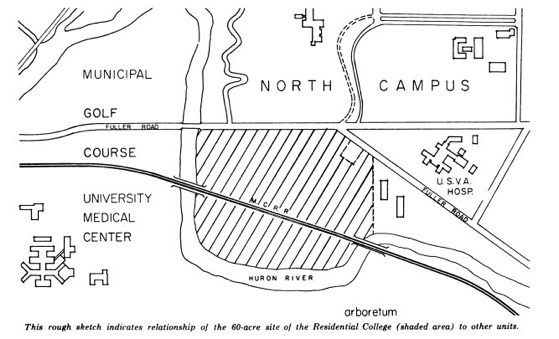The shaded area at bottom right will be the site of the Residential College. Main campus is across the river at upper left.
North Campus Site Selected For New, Self-Contained Unit
The University's Residential College will admit its first students in September, 1967, and will be housed in East Quadrangle until its own buildings can be constructed.
The Regents approved the Residential College concept and curriculum program and said the program should start in the East Quadrangle in 1967, looking toward occupancy of the North Campus site in the fall of 1969.
They indicated that the approval is subject to these conditions: that the architectural revisions now under study should lower the cost of the project so that no differential student fee will be required for financing the project; that the charges for the room and board will be compatible with rates charged elsewhere in the residence hall system for comparable facilities; and that the debt service applicable to the academic space included within the housing units shall not be borne by the student housing costs.
About 250 freshmen will be admitted as the first class. Admission of freshmen in each of the three succeeding years will bring the total enrollment of the college to about 1,200.
A site for the college already has been selected on the University's North Campus. Residences and educational buildings will be erected here, so that eventually the college will be a self-contained unit, although its students will be able to use the University's general resources, such as libraries, museums, and specialized equipment.
During the coming year, East Quadrangle will be remodeled to meet the needs of the Residential College. Classrooms and seminar rooms will be constructed in the Quadrangle, and provisions will be made for faculty residents as well as students.
The curriculum of the new college, as proposed by the faculty planning committee, will include a "core program" which all students will be required to complete in addition to the studies in their individual fields of concentration.
The core program will include (1) a freshman course in logic; (2) a series of courses in the history of Western man; (3) a series of courses in the social sciences, treating man's development as an individual and his behavior in societies of different sizes and kinds; (4) courses in the natural sciences, with different courses provided for science and non-science concentrates; (5) foreign language studies, "pursued to the point of fluency"; (6) instruction and actual practice in one of the arts; and (7) continuing evaluation of oral and written English throughout the student's four years in the college.
The planning committee has placed considerable emphasis upon the foreign language requirement of the new college. Each student will take proficiency examinations in his chosen language at the end of his sophomore year, and after that will also be required to complete at least one course taught in that language.
Students in the Residential College will have concentration programs, just as do other students in the Literary College. Completion of a major will require satisfactory performance on a comprehensive examination in that field, given during the senior year.
Curriculum plans, as accepted by the Regents, place much emphasis upon variety of class size and teaching method and upon independent study. Seminar instruction will begin at the freshman level.
When the Residential College has reached its maximum enrollment of 1,200, its faculty will total about 80 "full-time equivalents." All members of its faculty will also be members of the faculty of the College of Literature, Science, and the Arts and of the appropriate department of that College. Some Residential College faculty members will teach full-time in that unit, while some will divide their time between the Residential College and the Literary College.
Planning for the Residential College has been somewhat delayed because some construction cost estimates have been higher than anticipated. This has necessitated some cutbacks in the original planning.
The Residential College is one of the stated objectives of the University's $55 Million Program. Contributors to that program may designate their gifts for the Residential College.
Dr. Burton D. Thuma, associate dean of the Literary College, has been named director of the Residential College. East Quadrangle (above) will be the temporary home of the University's Residential College until new facilities are built on the North Campus.
The Michigan Alumnus
June 1966





